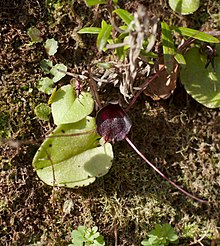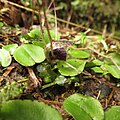
Corybas, commonly known as helmet orchids, is a genus of about 120 species of plants in the orchid family, Orchidaceae. Helmet orchids are small, perennial, deciduous herbs and are nearly always terrestrial. They have a single leaf at their base and a single flower on a short stalk, the flower dominated by its large dorsal sepal and labellum. Species of Corybas are found in Australia, New Zealand, New Guinea, Southeast Asia, the Himalayas, southern China, many Pacific islands and a few sub-Antarctic islands.
Corybas dienemus, commonly known as the windswept helmet-orchid, is one of two helmet orchids endemic to Australia's subantarctic Macquarie Island, and the first orchid to be found there. It is a relatively small orchid with green flowers with purplish-red markings and was discovered in 1978.

Corybas aconitiflorus, commonly known as the cradle orchid or spurred helmet orchid, is a species of terrestrial orchid endemic to eastern Australia, occurring from south-east Queensland to Tasmania. The small flowers have a hooded appearance as the uppermost sepal hides most of the rest of the flower. It is the type species of the genus Corybas.
Prasophyllum hectori, commonly known as the swamp leek orchid, is a species of orchid endemic to New Zealand. It has a single tubular, dark green leaf and up to eighty scented, yellow-green flowers with red or brown marking. It is similar to P. colensoi, the only other species of Prasophyllum found in New Zealand, but is distinguished from it by its larger size, larger number of flowers and swampy habitat.
Corybas globulus is a species of helmet orchid endemic to a small area of the New England Tableland in northern New South Wales. It is a relatively small orchid with a bright green, heart-shaped leaf and a bulbous, dark reddish purple flower.

Corybas acuminatus, commonly known as the dancing spider orchid or helmet flower, is a species of terrestrial orchid endemic to New Zealand. It has a triangular, sharply pointed leaf and a small translucent, greenish-white flower with purple markings and with very long sepals. It is found on both the main islands of New Zealand and also some of the off-shore islands.
Corybas cerasinus, commonly known as the red helmet orchid, is a species of terrestrial orchid endemic to tropical north Queensland. It has a single bluish green, heart-shaped leaf and a cherry red to dark maroon flower with its curved dorsal sepal obscuring its labellum which has an upturned tip.

Corybas cheesemanii, commonly known as Cheesemans spider orchid or spurred helmet orchid, is a species of terrestrial orchid endemic to New Zealand. It is a small orchid with a single pale green, heart-shaped leaf and usually only a single flower variously coloured from maroon to completely white. It usually grows in deep shade, often in deep leaf litter and flowers in autumn and winter.
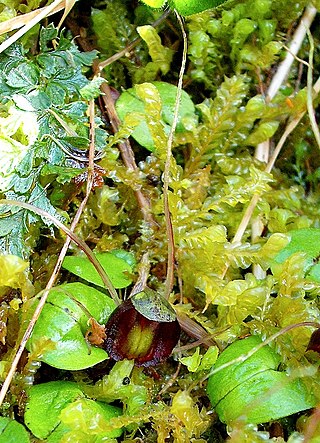
Corybas confusus, commonly known as the spider orchid is a species of terrestrial orchid endemic to New Zealand. It has a single heart-shaped leaf and a single dark green or light green flower with reddish maroon streaks and blotches and long, thread-like lateral sepals and petals. It grows in highland areas on both main islands.
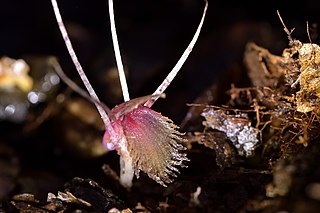
Corybas cryptanthus, commonly known as the hidden spider orchid or icky, is a species of terrestrial orchid endemic to New Zealand. It has no obvious leaves and the mostly white flower is usually buried in leaf litter. The plant is usually only detected by its fruiting capsule which is borne on a stem which elongates up to 280 mm (10 in) high.

Corybas fimbriatus, commonly known as the fringed helmet orchid, is a species of terrestrial orchid endemic to eastern Australia. It has a broad egg-shaped to round leaf and a dark reddish purple to crimson flower with translucent patches. It is similar to C. hispidus but its labellum lacks a creamy-white centre and is not covered with bristly hairs.
Corybas fordhamii, commonly known as the banded helmet orchid or swamp helmet orchid, is a species of terrestrial orchid endemic to south-eastern Australia. It has an egg-shaped to heart-shaped leaf and a reddish to reddish purple flower which leans forward. It is similar to C. unguiculatis which does not grow in swamps and has a different labellum.

Corybas oblongus is a species of terrestrial orchid endemic to New Zealand. It has a solitary oval-shaped leaf, often patterned with maroon, and a reddish-purple and white flower with a fimbriate labellum.
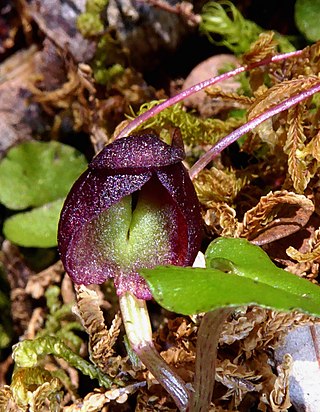
Corybas obscurus is a species of terrestrial orchid endemic to New Zealand. It has a solitary heart-shaped leaf and a deep crimson or nearly black flower and is part of the Corybas trilobus aggregate.

Corybas trilobus is a species of terrestrial orchid endemic to New Zealand. It is part of the C. trilobus aggregate, whose members are characterized by a funnel or dish-shaped labellum and an often heart or kidney-shaped solitary leaf.

Corybas sanctigeorgianus is a species of terrestrial orchid endemic to the North Island of New Zealand. It is part of the C. trilobus aggregate, whose members are characterized by a funnel or dish-shaped labellum and an often heart or kidney-shaped solitary leaf.

Corybas hatchii is a species of terrestrial orchid endemic to New Zealand. It has a solitary rounded leaf, often flecked with maroon, and a single pale green and maroon flower with long, threadlike lateral sepals and petals.
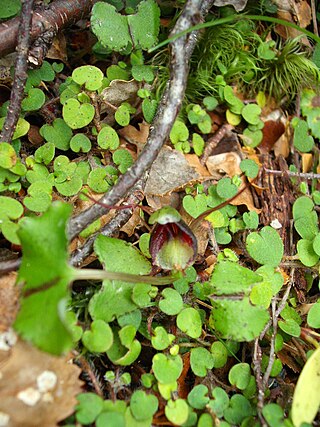
Corybas hypogaeus is a species of terrestrial orchid endemic to the New Zealand. It is part of the C. trilobus aggregate, whose members are characterized by a funnel or dish-shaped labellum and an often heart or kidney-shaped solitary leaf.
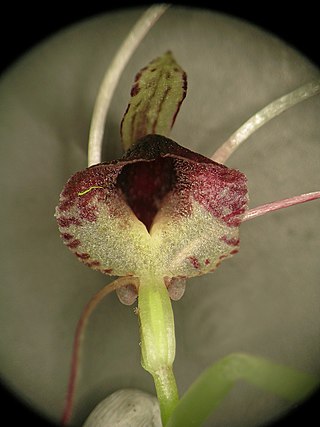
Corybas papillosus is a species of terrestrial orchid endemic to the New Zealand. It has a solitary rounded leaf with a heart-shaped base and a single flower with a long, slender green dorsal sepal, as well as a crimson and white labellum.
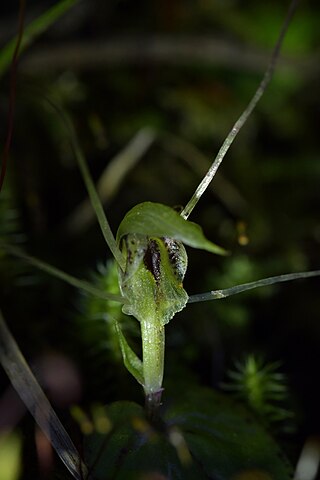
Corybas papa is a species of terrestrial orchid endemic to the North Island of New Zealand. It has a solitary wedge-shaped leaf and single translucent green flower with a strongly deflexed labellum and slender, threadlike lateral sepals and petals.
